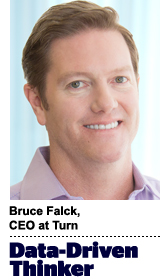 “Data-Driven Thinking” is written by members of the media community and contains fresh ideas on the digital revolution in media.
“Data-Driven Thinking” is written by members of the media community and contains fresh ideas on the digital revolution in media.
Today’s column is by Bruce Falck, CEO at Turn.
In 1968, 3M scientist Spencer Silver invented an adhesive that could stick to a surface over and over without leaving residue when removed. The invention wasn’t an overnight success; Silver’s colleagues were convinced the value was in a stronger adhesive, not a weaker one. Twelve years later, the Post-It launched. The so-called weak adhesive made for a stronger product – and one that has been both incredibly valuable as well as “sticky” with consumers for a very long time.
Similarly, we are learning what makes programmatic truly sticky for marketers. It is moving from an emphasis on technology as a way to buy cheap, remnant media to a driver of invaluable customer insights that can impact everything from targeting to package design.
This is a happy occurrence for those marketers who have been flexible enough in their thinking to recognize this opportunity. I think that was the key change in the market in 2016 and one that will continue into 2017: Conversations about programmatic have evolved from click-through rates and costs per acquisition to insights gleaned from the customer journey.
The Evolution Of Programmatic
Programmatic’s rise in the early 2000s was driven by two factors – the need to get rid of remnant inventory in media and the need for better online targeting. So right from the beginning, the idea of using data to target consumers was integral to programmatic. However, the remnant inventory function overshadowed programmatic’s targeting aspects. As a result, programmatic was viewed as a vehicle for purchasing. This is still largely the case.
Historically, programmatic was seen as cheap or efficient media. The world is moving to a better understanding, however, of programmatic being a technology by which all media will be bought. Programmatic now composes more than two-thirds of all display sales in the US and will jump to 72% in the coming year, according to eMarketer.
When you’re doing pretty much all of your buying via programmatic, it’s no longer accurate to say that its primary value is cost savings. Just like cloud computing, price may have initially been the draw, but when companies adopted the cloud, they realized that they could be much more agile and innovative because they could try out new ideas and scale them quickly.
In the case of programmatic, marketers are realizing that a secondary benefit – new data on customers – isn’t so secondary. Applying such data lets those brands have conversations with consumers that are much more useful and productive. It’s not unusual for marketers to remark that this is data that they’ve never seen before.
While the standard model may have been to conduct research and then use programmatic to execute a campaign, programmatic insights have turned that on its head. Now it’s possible to unearth insights via programmatic that can drive the creation of campaigns, not to mention other functions of marketing. For example, what if a CPG company could use programmatic insights to customize packaging for a segment of consumers it didn’t know it was reaching? Or if an auto company could tweak its creative to highlight certain features over others?
2017 And Beyond
As we look ahead in 2017, I still see lightbulbs going off as marketers realize that programmatic advertising is a powerful vehicle for new customer data. Throughout 2016, this enlightenment spread among marketers; in 2017, this belief will become mainstream.
This paradigm shift will come as more marketers realize that customer data is their best asset. When one takes a big-picture look, it’s even more than that. The value in programmatic is the data, which powers new products, marketing and insights about everything from the eradication of diseases to autonomous vehicles.
As with Spencer Silver’s Post-It, we are just beginning to realize what we’ve discovered.
Follow Bruce Falck (@brucefalck), Turn (@TurnPlatform) and AdExchanger (@adexchanger) on Twitter.













